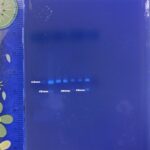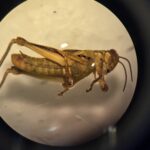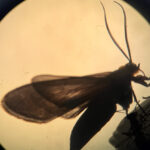Sample information |
|
| Picture |

|
|---|---|
| Location | |
| Collection date | 04/30/2025 |
| Captive / Cultivated? | Wild-caught |
| Group | California Academy of Mathematics and Science |
| Observations | |
| Putative identification | Arthropoda Malacostraca Isopoda Armadillidae Armadillidium Armadillidium vulgare |
Methods |
|
| Extraction kit | DNeasy (Qiagen) |
| DNA extraction location | Abdomen |
| Single or Duplex PCR | Duplex Reaction |
| Gel electrophoresis system | Standard electrophoresis system Bio-Rad |
| Buffer | 1X TAE |
| DNA stain | UView |
| Gel images |


|
| Protocol notes | During the process of DNA extraction, there was some difficulty separating the tissue from the exoskeleton, possibly leading to a lower quality extraction. Gel 1 Gel 2 Our first gel’s ladder did not run successfully, so we ran another gel with the same ladder and and another MiniOne ladder and compared the relative mobilities of the two gels to determine the base pairs of the first gel. |
Results |
|
| Wolbachia presence | Yes |
| Confidence level | Medium |
| Explanation of confidence level | Although our controls worked, we are unsure of why our ladder did not run, so the results of our gel are somewhat questionable. However, all of the samples ran correctly, with aligned bands that were only in expected locations. As stated before, there were some complications with the DNA extraction, but we were also able to visualize a band for Wolbachia when we ran our gel. Our Sanger Sequencing results also had a less than ideal contiguous read length value. |
| Wolbachia 16S sequence | Download FASTA
GNNNNNNNNNNNNNNNGGTGTTGCATGGCTGTCGTCAGCTCGTGTCGTGAGATGTTGGGTTAAGTCCCGCAACGAGCGCA ACCCTCATCCTTAGTTACCATCAGATAATGCTGGGGACTTTAAGGAAACTGCTAGTGATAAACTGGAGGAAGGTGGGGAT GATGTCAAGTCATCATGGCCCTTATGGAGTGGGCTACACACGTGCTACAATGGTGGCTACAATGGGCTGCAAAGTCGCGA GGCTAAGCTAATCCCTTAAAAGCCATCTCAGTTCGGATTGCACTCTGCAACTCGAGTGCATGAAGTTGGAATCGCTAGTA ATCGTGGATCAGCATGCCACGGTGAATACGTTCTCGGGTCTTGTACACACTGCCCGTCACGCCATGGGAATTGGTTTCNN NCGAAGNNNN
BLAST at The Wolbachia Project BLAST at NCBI
|
| Arthropod COI sequence | Download FASTA
NNNNNNNGNNNTGGGGTTTGAGCAGGGGCTGTTGGAACTGCCCTTAGAATAATTATTCGCACTGAATTAGGACAACCTGG AAGTTTAATTGGAGATGACCAGATTTACAATGTAATTGTAACTGCTCATGCTTTTGTAATAATTTTTTTTATAGTAATAC CTATTATAATTGGTGGATTTGGTAATTGGTTAATTCCATTAATACTAGGAGCCCCAGATATGGCTTTTCCACGAATAAAT AATATAAGATTTTGACTTTTACCCCCTTCTTTAACTTTATTGCTTAGAAGTGGGTTGGTTGAAAGAGGAGTAGGAACAGG ATGGACAGTATATCCTCCGCTGGCGTCTAGAATTGCTCATAGAGGAGCATCTGTAGATTTAGGTATTTTTTCTCTCCACC TTGCTGGAGCTTCTTCTATTTTAGGGGCTGTGAATTTTATTACTACTATAATTAATATACGAGCAGCTGGAATTAGAATA GACCGTGTTCCTTTATTTGTTTGATCAGTATTAGTAACGGCTGTACTTTTACTTTTATCCCTACCTGTATTAGCAGGAGC TATTACTATATTATTAACTGATCGAAATTTAAATACCTCTTTTTTTGACCCTAGGGGAGGAGGAGACCCTATCCTTTATC AACACTTATTTTGATTTTTTGGTCACCNNGNAGGTTNA
BLAST at The Wolbachia Project BLAST at NCBI
|
| Summary | The Armadillidium vulgare was found to be postive for Wolbachia. |
 Differential Grasshopper – Melanoplus differentialis
Differential Grasshopper – Melanoplus differentialis Pill Bug (Armadillidium vulgare) – Draft
Pill Bug (Armadillidium vulgare) – Draft Melanoplus Femurrubrum
Melanoplus Femurrubrum Grasshopper – Orthoptera
Grasshopper – Orthoptera Cisseps Fulvicollis
Cisseps Fulvicollis